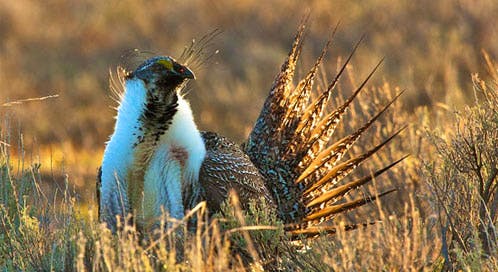There’s a new documentary making the rounds, getting high reviews, and for good reason. Adapted from the acclaimed book, Merchants of Doubt by Harvard historian Naomi Oreskes and NASA historian Erik Conway, the film by the same name is a cutting exposé on strategies by certain industries to spend huge amounts of money to employ “highly charismatic, silver-tongued pundits-for-hire” who muddle the discourse (and facts) on public health and safety. Their goal: to create uncertainty about well-established public threats ranging from toxic chemicals to cigarette smoke to climate change. The first step in their campaign: question scientists and discredit their work.
Now industry has unleashed this tactic on current efforts to protect sage-grouse. Last week, a coalition of industries and some western counties filed petitions with the Department of the Interior challenging the science that serves as the foundation for the National Greater Sage-Grouse Planning Strategy. This unprecedented planning process aims to improve sage-grouse conservation on more than 60 million acres of public land. Let’s hope this cynical ploy does not distract states and federal agencies from this important work.
(story continues below)

Industry has challenged Greater Sage-Grouse: Ecology and Conservation of a Landscape Species and Its Habitat, a monograph written by 38 experts on sage-grouse, sagebrush steppe and land management, published by the Cooper Ornithological Society in Studies in Avian Biology, and printed by the University of California Press. It is the most important work ever written on sage-grouse by all of the most accomplished people who study the species.
We know more about sage-grouse than most any other wildlife species in the country, thanks to dedicated scientists who have committed their lives to studying the bird. These scientists have published hundreds of peer-reviewed articles on sage-grouse, and recently compiled their decades of work into an impressive monograph on the species. I have worked to conserve sage-grouse for 15 years, and I am privileged to know many of these scientists and to read their work. They are, every one of them, thoughtful, sincere professionals devoted to understanding a complex species and its fragile habitat.
These scientists sounded the alarm on sage-grouse years ago, having documented widespread habitat loss and degradation, and long-term population declines. It is their research that also provides a blueprint for restoring the species and its habitat. If put into practice, their recommendations could protect and recover sage-grouse, and also benefit hundreds of other species that depend on the sagebrush grasslands. But failure to take these steps could result in further declines of sage-grouse and their habitat.
The latest industry challenges to sage-grouse science follows sobering news that firms spent at least $9 million last year lobbying Congress on sage-grouse issues. The biggest spenders were Anadarko Petroleum Corp. ($3.1 million), National Rural Electric Cooperative Association ($2.1 million) and Chesapeake Energy ($1.8 million). Safe to say, they probably were not lobbying for stronger protections for the species.
It’s beyond time to protect sage-grouse and the quintessential western landscape where they live. Doing so benefits everyone. Instead of undermining the effort by trying to discredit science, industry should join with federal agencies and states, conservationists and other stakeholders to protect and recover this remarkable bird.



